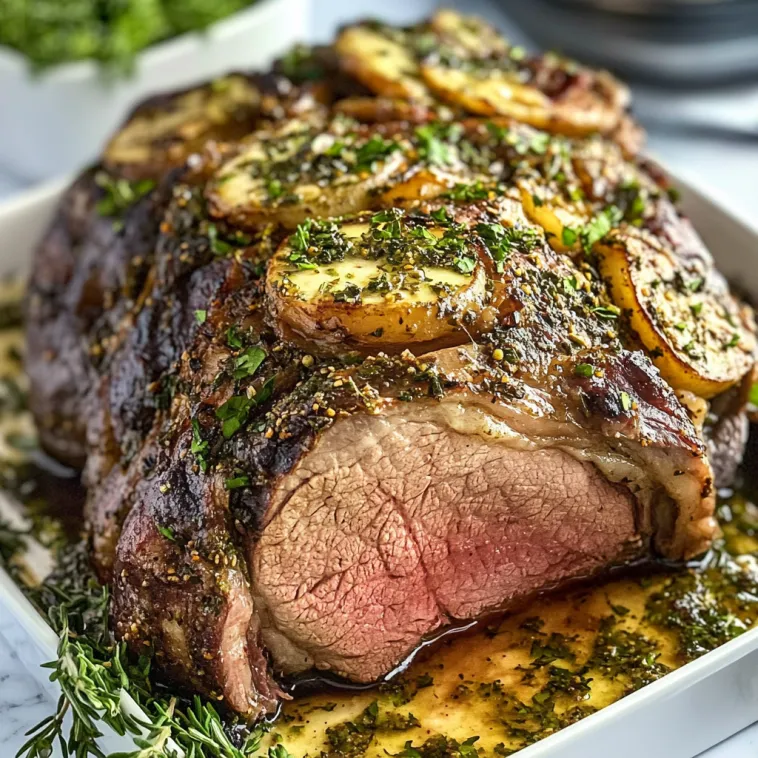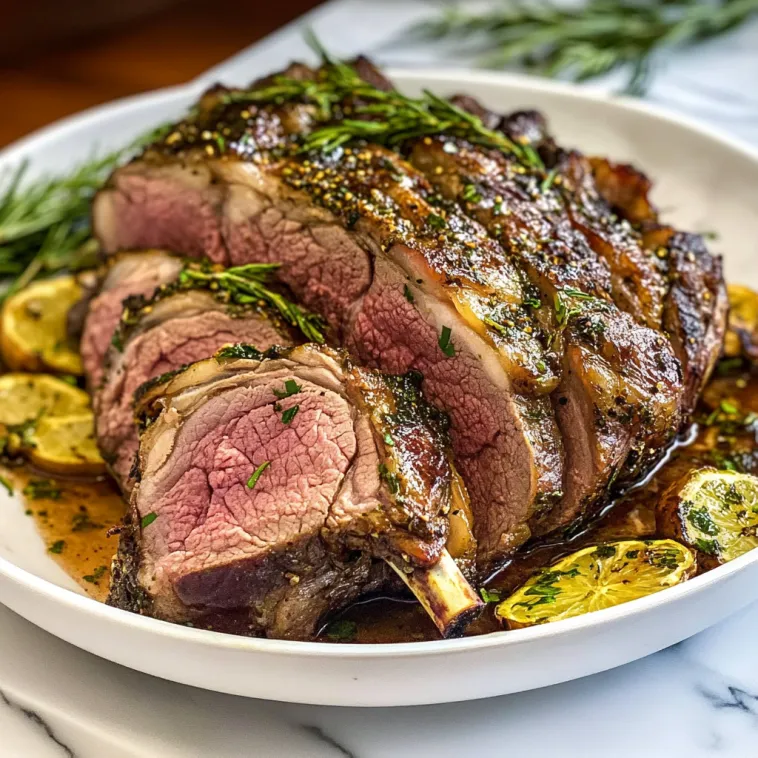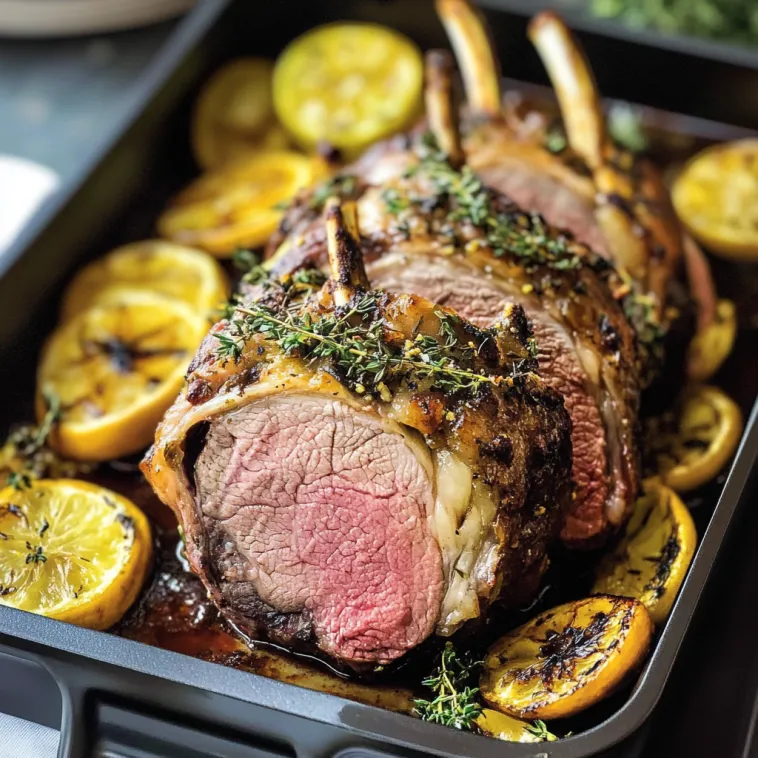 Bookmark
Bookmark
This Italian marinated leg of lamb transforms an ordinary dinner into a celebration. The aromatic herbs and zesty marinade infuse the meat with complex flavors while the roasting method ensures a juicy interior and crispy exterior that will impress even the most discerning guests.
I first prepared this lamb for my in laws during Easter several years ago and the tradition has stuck. Even family members who claimed not to enjoy lamb have become converts after trying this flavorful preparation.
Ingredients
- Leg of lamb: 4 to 5 pounds select bone in for maximum flavor or boneless for easier carving
- Olive oil: the foundation of our marinade using extra virgin provides the best Mediterranean flavor profile
- Balsamic vinegar: adds depth and subtle sweetness that helps tenderize the meat
- Garlic: essential aromatic that penetrates the lamb beautifully during marination
- Fresh rosemary: classic lamb pairing with intense pine like fragrance
- Fresh thyme: adds earthy complexity to balance the stronger herbs
- Dijon mustard: works as an emulsifier while adding tangy depth
- Honey: optional but creates beautiful caramelization during roasting
- Lemon zest and juice: brightens all flavors and gently tenderizes the meat
- Red pepper flakes: provides subtle heat that enhances rather than overwhelms
Step-by-Step Instructions
- Prepare the Marinade:
- Whisk together olive oil and balsamic vinegar until beginning to emulsify. Add minced garlic ensuring it's finely cut to release maximum flavor. Incorporate chopped herbs making sure they're evenly distributed. Blend in Dijon mustard which helps bind everything together. Finally add lemon components and seasonings stirring until completely combined into a fragrant mixture.
- Marinate the Lamb:
- Place lamb in either a large ziplock bag or shallow dish with sides tall enough to contain liquid. Pour marinade over every surface using your hands to massage into the meat if needed. Seal container tightly and refrigerate for at least 4 hours though overnight delivers significantly better flavor penetration. Turn the meat occasionally if possible.
- Prepare for Roasting:
- Remove lamb from refrigerator about 30 minutes before cooking to take the chill off. Preheat oven thoroughly to 400°F ensuring proper temperature before the lamb goes in. If using boneless cut tie with kitchen twine at 1 inch intervals to maintain even shape during cooking.
- Roast the Lamb:
- Position lamb on a rack within a roasting pan so air circulates underneath. Begin with high heat roasting to develop a flavorful crust then reduce temperature for gentle cooking. Use a reliable meat thermometer inserted into the thickest part avoiding bone for accurate readings. For medium rare aim for 135°F interior temperature.
- Rest and Serve:
- Allow lamb to rest under loose foil tent for 15 full minutes after removing from oven. This critical step allows juices to redistribute throughout the meat. Slice against the grain in medium thick pieces for the perfect texture and presentation.
 Bookmark
Bookmark
The balsamic vinegar in this recipe is my secret weapon. While many lamb recipes call for lemon alone I find the depth and subtle sweetness of quality balsamic creates caramelization on the outside while keeping the interior incredibly moist. My grandmother from Sicily always said lamb needs a touch of sweetness to balance its natural character.
Make Ahead Tips
The lamb can be marinated up to 24 hours in advance making this perfect for entertaining. Simply prepare the marinade mix with the lamb and refrigerate overnight. The longer marination actually improves flavor development creating an even more tender result. Remove from refrigerator 30 minutes before cooking to allow for more even roasting.
Perfect Sides to Serve
This Italian lamb pairs beautifully with roasted potatoes that can cook alongside in the same oven. Toss baby potatoes with olive oil rosemary salt and pepper arranging them around the lamb during the last 45 minutes of cooking. A simple arugula salad dressed with lemon and olive oil provides the perfect peppery contrast to the rich meat. For a complete Italian inspired meal serve with sautéed broccolini finished with garlic and red pepper flakes.
Choosing the Best Lamb
American and New Zealand lamb offer different flavor profiles. American lamb tends to be larger with a slightly stronger flavor while New Zealand lamb is typically smaller with a milder taste. For this recipe either works beautifully but I prefer American lamb for its robust character that stands up to the strong Mediterranean herbs. When selecting your cut ask for a semi trimmed leg with just enough fat cap to baste the meat naturally during roasting.
 Bookmark
Bookmark
Frequently Asked Questions
- → How long should I marinate the leg of lamb?
For best results, marinate the leg of lamb for at least 4 hours, but ideally overnight (8-12 hours). This allows the aromatic flavors from the herbs, garlic, and balsamic vinegar to fully penetrate the meat, resulting in a more flavorful final dish.
- → What internal temperature should I aim for when cooking lamb?
For medium-rare lamb, aim for an internal temperature of 135°F (57°C). For medium, target 145°F (63°C), and for well-done, 160°F (71°C). Always use a meat thermometer inserted into the thickest part of the meat for accuracy.
- → Why is resting the lamb important after cooking?
Resting the lamb for 10-15 minutes after cooking allows the meat juices to redistribute throughout, resulting in more tender, juicy meat. If you slice it immediately, those flavorful juices will run out onto your cutting board instead of remaining in the meat.
- → Can I use dried herbs instead of fresh?
Yes, you can substitute dried herbs for fresh in the marinade. As a general rule, use 1 teaspoon of dried herbs for every tablespoon of fresh herbs called for. Dried herbs have more concentrated flavor than fresh.
- → What sides pair well with Italian marinated lamb?
This lamb pairs beautifully with roasted potatoes, grilled vegetables, risotto, or polenta. For a complete Italian-inspired meal, consider serving it with a fresh arugula salad dressed with lemon and olive oil, and some crusty bread to soak up the juices.
- → Should I roast a bone-in or boneless leg of lamb?
Both options work well. Bone-in lamb typically has more flavor and remains juicier during cooking, while boneless is easier to carve. If using boneless, tie it with kitchen twine before roasting to help it cook evenly and maintain a nice shape.
